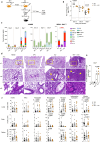Prior infection with unrelated neurotropic virus exacerbates influenza disease and impairs lung T cell responses
- PMID: 38521764
- PMCID: PMC10960853
- DOI: 10.1038/s41467-024-46822-7
Prior infection with unrelated neurotropic virus exacerbates influenza disease and impairs lung T cell responses
Abstract
Immunity to infectious diseases is predominantly studied by measuring immune responses towards a single pathogen, although co-infections are common. In-depth mechanisms on how co-infections impact anti-viral immunity are lacking, but are highly relevant to treatment and prevention. We established a mouse model of co-infection with unrelated viruses, influenza A (IAV) and Semliki Forest virus (SFV), causing disease in different organ systems. SFV infection eight days before IAV infection results in prolonged IAV replication, elevated cytokine/chemokine levels and exacerbated lung pathology. This is associated with impaired lung IAV-specific CD8+ T cell responses, stemming from suboptimal CD8+ T cell activation and proliferation in draining lymph nodes, and dendritic cell paralysis. Prior SFV infection leads to increased blood brain barrier permeability and presence of IAV RNA in brain, associated with increased trafficking of IAV-specific CD8+ T cells and establishment of long-term tissue-resident memory. Relative to lung IAV-specific CD8+ T cells, brain memory IAV-specific CD8+ T cells have increased TCR repertoire diversity within immunodominant DbNP366+CD8+ and DbPA224+CD8+ responses, featuring suboptimal TCR clonotypes. Overall, our study demonstrates that infection with an unrelated neurotropic virus perturbs IAV-specific immune responses and exacerbates IAV disease. Our work provides key insights into therapy and vaccine regimens directed against unrelated pathogens.
© 2024. The Author(s).
Conflict of interest statement
The authors declare no competing interests.
Figures








References
MeSH terms
Substances
Grants and funding
LinkOut - more resources
Full Text Sources
Medical
Molecular Biology Databases
Research Materials
Miscellaneous

